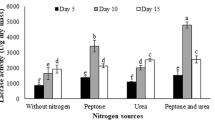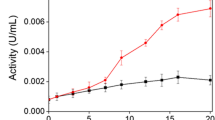Abstract
The effect of different metal ions and two redox mediators on laccase activity and laccase-catalyzed decolorization of five synthetic dyes was investigated in vitro using crude laccase from a novel white rot fungus Peniophora sp. (NFCCI-2131). The fungus effectively decolorized crystal violet and brilliant green on malt extract agar medium. Laccase activity was enhanced by metal ions such as Cd2+, Mn2+, Ni2+, Co2+, Na+ Ca2+, and Cu2+. Among the different dyes tested, highest decolorization of crystal violet (96.30 %) was obtained in the presence of 1 mM ABTS followed by 86.01 % by HBT. The results conspicuously indicated that laccase from Peniophora sp. has the potential for color removal from textile dye effluent even in the presence of toxic metal ions.








Similar content being viewed by others
Abbreviations
- MEA:
-
Malt extract agar
- ABTS:
-
2,2’-Azino-bis(3-ethylbenzthiazoline-6-sulphonic acid)
- HBT:
-
1-Hydroxybenzotriazole
- NFCCI:
-
National Fungal Culture Collection of India
- ARI:
-
Agharkar Research Institute
- ppm:
-
Parts per million
- mM:
-
Millimolar
- mm d−1 :
-
Millimeter per day
References
Majeau, J. A., Brar, S. K., & Tyagi, R. D. (2010). Bioresource Technology, 101, 2331–2350.
Pereira, L., Coelho, A. V., Viegas, C. A., Santos, M. M., Robalo, M. P., & Martins, L. O. (2009). Journal of Biotechnol, 139, 68–77.
Brown, M. A., & De Vito, S. C. (1993). Critical Reviews in Environmental Science and Technology, 23, 249–324.
Asgher, M., Yasmeen, Q., Muhammad, H., & Iqbal, N. (2013). Saudi Journal of Biological Sciences, 20(4), 347–352.
Ali, N. F., & El-Mohamedy, R. S. R. (2012). Jounal of Saudi Chemical Society, 16(2), 117–123.
Asgher, M., Bhatti, H. N., Ashraf, M., & Legge, R. L. (2008). Biodeg, 19, 771–783.
Pointing, S. B. (2001). Applied Microbiology and Biotechnology, 57, 20–33.
Thurston, C. F. (1994). Microbiology, 140, 19–26.
Gianfreda, L., Xu, F., & Bollag, J. M. (1999). Bioremediation Journal, 3, 1–25.
Canas, A., & Camarero, S. (2010). Biotechnology Advances, 28(6), 694–705.
Hsu, C. A., Wen, T. N., Su, Y. C., Jiang, Z. B., Chen, C. W., & Shyur, L. F. (2012). Environmental Science and Technology, 46, 5109–5117.
Wesenberg, D., Kyriakides, I., & Agathos, S. N. (2003). Biotechnology Advances, 22, 161–187.
Murugesan, K., Kim, Y. M., Jeon, J. R., & Chang, Y. S. (2009). Journal Hazardous Materials, 168(1), 523–529.
Karam, J., & Nicell, J. A. (1997). Journal of Chemical Technology and Biotechnology, 69, 141–153.
Couto, S. R., Sanroman, M. A., & Gubitz, G. M. (2005). Chemotherapy, 58, 417–422.
Murugesan, K., Nam, I. H., Kim, Y. M., & Chang, Y. S. (2007). Enzyme and Microbial Technology, 40, 1662–1672.
Shankar, S., & Nil, S. (2012). Applied Biochemistry and Biotechnol, 166, 1082–1094.
Unal, A., & Kolankaya, N. (2004). Turkish elect. Journal of Biotechnology, 2, 17–21.
Pointing, S. B., Bucher, V. V. C., & Vrijmoed, L. L. P. (2000). World Journal of Microbiology and Biotechnology, 16, 199–205.
Hatvani, N., & Mécs, I. (2001). Process Biochemistry, 37, 491–496.
Johannes, C., & Majcherczyk, A. (2000). Applied and Environmental Microbiology, 66, 524–528.
Husain, H. (2006). Critical Reviews in Biotechnology, 26, 201–221.
Niku-Paavola, M. L., Fagerstrom, R., Kruus, K., & Viikari, L. (2004). Enzyme and Microbial Technology, 35, 100–102.
Machado, K. M. G., Matheus, D. R., & Bononi, V. L. R. (2005). World Journal of Microbiology and Biotechnology, 21, 297–301.
Barrasa, J. M., Martı’nez, A. T., & Martı’nez, M. J. (2009). Folia Microbiology, 54(1), 59–66.
Aksu, Z., Kilic, N. K., Ertugrul, S., & Donmez, G. (2007). Enzyme and Microbial Technology, 40, 1167–1174.
Claus, H., Faber, G., & König, H. (2002). Applied Microbiology and Biotechnology, 59, 672–678.
Nyanhongo, G., Gomes, J., Gübitz, G., Zvauya, R., Read, J., & Steiner, W. (2002). Bioresource Technology, 84(3), 259–263.
Mechichi, T., Mhiri, N., & Sayadi, S. (2005). Chemotheraphy, 64, 998–1005.
Acknowledgment
The authors wish to thank the Council of Science and Technology, U.P., for a research grant to Shikha and the University Grants Commission, New Delhi for Rajiv Gandhi National fellowship to Shiv Shankar.
Author information
Authors and Affiliations
Corresponding author
Rights and permissions
About this article
Cite this article
Shankar, S., Nill, S. Effect of Metal Ions and Redox Mediators on Decolorization of Synthetic Dyes by Crude Laccase from a Novel White rot Fungus Peniophora sp. (NFCCI-2131). Appl Biochem Biotechnol 175, 635–647 (2015). https://doi.org/10.1007/s12010-014-1279-2
Received:
Accepted:
Published:
Issue Date:
DOI: https://doi.org/10.1007/s12010-014-1279-2




